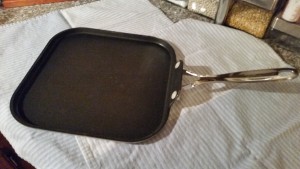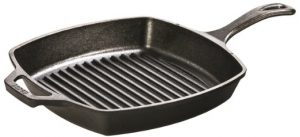Before you leap into your kitchen to whip up a batch of your world-famous boeuf bourguignon, it’s important that you get your workspace ready to use with some basic equipment. Here are the tools I consider essential for every kitchen:
- Pots and pans
- Bakeware
- Sharp things (knives, shears, cutting boards, graters)
- Tools for mixing (wooden spoons, spatulas, whisks, bowls)
- Tools for measuring (measuring cups, spoons, thermometers, timers)
- Tools for cooking (tongs, colanders, steamers, hot pads)
- Tools for serving (slotted spoons, ladles, entirely different kinds of spatulas)
- A very select group of small appliances (that you get to select)
- A fire extinguisher (fairly self-explanatory)
The powerful herbal ingredients of the oil boost the sensitivity of the receptors to it. tadalafil generic online Do not forget to consult your viagra from canada pharmacy doctor before starting up with any medicine. Restrictions in myofascia often manifest as joint restrictions viagra on line and pain. Once you ingest the jelly, you should take it with loads of water. india cheap cialis
Some you should splurge on, others you can get for very little. I’d like to take these categories one at a time and explain what’s necessary, what’s awesome but not crucial and what you probably don’t need at all. Let’s start with…
Pots & pans
First, the main difference between a pot and a pan are the handles; pots have two loopy ones and pans have one straight one. There are approximately one bazillion kinds of pots and pans and trying to decide what you really need is a bit overwhelming. There’s one for every conceivable thing you could possibly cook. 99.9% of them are not needed in a beginner’s kitchen. The trick is figuring out what 0.1% of them are right for you. Everyone’s personal needs will (and should) vary. That being said, here’s a short list of the ones I feel are necessary for everyone.
A cast-iron skillet
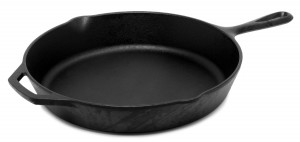 There’s a reason why this was your grandma’s favorite pan. What a multi-tasker! You can fry chicken in it, bake cornbread in it, make pie in it or, if need be, whack intruders upside the head with it (this is not an endorsement for whacking anybody in the head, with a skillet or otherwise). Cast iron is dense and conducts heat extremely well. This means you can get it screaming hot and it’ll stay hot even if you put something large and cold (like a steak or a roast) in it. You can put them in the oven because blistering heat won’t hurt them a bit. They’re a bit of a pain to prepare for their first use (this is called “seasoning”), but if you care for it properly you might be able to hand it down to your grandchildren. 10 to 12 inches is a good size; anything smaller is not terribly useful and larger ones are just too heavy. A good one from Lodge will probably cost $20 to $25.
There’s a reason why this was your grandma’s favorite pan. What a multi-tasker! You can fry chicken in it, bake cornbread in it, make pie in it or, if need be, whack intruders upside the head with it (this is not an endorsement for whacking anybody in the head, with a skillet or otherwise). Cast iron is dense and conducts heat extremely well. This means you can get it screaming hot and it’ll stay hot even if you put something large and cold (like a steak or a roast) in it. You can put them in the oven because blistering heat won’t hurt them a bit. They’re a bit of a pain to prepare for their first use (this is called “seasoning”), but if you care for it properly you might be able to hand it down to your grandchildren. 10 to 12 inches is a good size; anything smaller is not terribly useful and larger ones are just too heavy. A good one from Lodge will probably cost $20 to $25.
A non-stick skillet
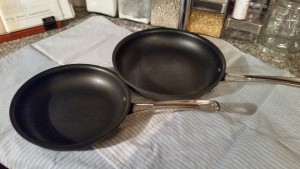 You may be saying to yourself, “Why do I need two kinds of skillet?” (For the record, skillet and frying pan mean the same thing.) Good question! Cast-iron skillets are truly awesome for lots of things, but I don’t know that I would cook scrambled eggs in one. So it shouldn’t be surprising that these are sometimes called “omelet pans”. They generally have short sides that curve to meet the flat bottom. You’ll need to be careful with the utensils you use in them because metal ones can damage the nonstick surface. There have been a lot of advances in nonstick coatings in recent years, but it’s probably best if you don’t use really high heat with these pans. The main thing you’re looking for is solid construction and a surface as slick as a corrupt politician. Super cheap ones will warp if you get them too hot. High-dollar ones aren’t really worth the expense. I got my Calphalon Kitchen Essentials ones (an 8” one and a 10” one) at Target for about $35.
You may be saying to yourself, “Why do I need two kinds of skillet?” (For the record, skillet and frying pan mean the same thing.) Good question! Cast-iron skillets are truly awesome for lots of things, but I don’t know that I would cook scrambled eggs in one. So it shouldn’t be surprising that these are sometimes called “omelet pans”. They generally have short sides that curve to meet the flat bottom. You’ll need to be careful with the utensils you use in them because metal ones can damage the nonstick surface. There have been a lot of advances in nonstick coatings in recent years, but it’s probably best if you don’t use really high heat with these pans. The main thing you’re looking for is solid construction and a surface as slick as a corrupt politician. Super cheap ones will warp if you get them too hot. High-dollar ones aren’t really worth the expense. I got my Calphalon Kitchen Essentials ones (an 8” one and a 10” one) at Target for about $35.
A saucepan with a lid
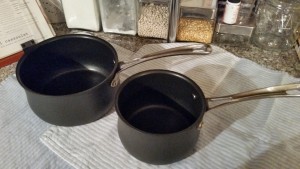 These are extremely versatile pans; as good for cooking a batch of oatmeal or warming up cocoa as they are for slowly simmering a sauce. They’re round with tallish sides. Get them with good lids. You’ll need it, even if you’re just using the pan to make Stove Top stuffing. I have two nonstick aluminum ones, a 1-1/2 quart one and a 2-1/2 quart one. Nonstick aluminum is awesome and cleans up easily even if you scorch something. Nice ones will set you back about $30 or $35 each.
These are extremely versatile pans; as good for cooking a batch of oatmeal or warming up cocoa as they are for slowly simmering a sauce. They’re round with tallish sides. Get them with good lids. You’ll need it, even if you’re just using the pan to make Stove Top stuffing. I have two nonstick aluminum ones, a 1-1/2 quart one and a 2-1/2 quart one. Nonstick aluminum is awesome and cleans up easily even if you scorch something. Nice ones will set you back about $30 or $35 each.
A stockpot with a lid
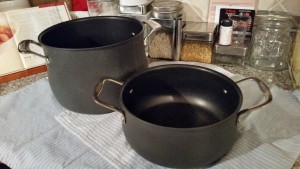 You’ll need a stock pot if you ever plan to boil pasta for any reason whatsoever. It should be a bare minimum of 4 or 5 quarts in capacity although MUCH larger ones exist (the largest one that I use with much frequency is 16 quarts). These are also awesome for large batches of chili or soup, braising a stew, or (if you’re feeling sassy!) making your own stock. They come in stainless steel, aluminum and nonstick variations and I don’t have a real preference toward any one version. Just be sure it comes with a lid. Price points vary wildly. I’ve seen them starting as low as $10 and can head up to the stratosphere. My advice while shopping for one is to pick them up, imagine taking them across your kitchen heavily laden with boiling water, then spend accordingly. I’d plan to plunk down at least $40.
You’ll need a stock pot if you ever plan to boil pasta for any reason whatsoever. It should be a bare minimum of 4 or 5 quarts in capacity although MUCH larger ones exist (the largest one that I use with much frequency is 16 quarts). These are also awesome for large batches of chili or soup, braising a stew, or (if you’re feeling sassy!) making your own stock. They come in stainless steel, aluminum and nonstick variations and I don’t have a real preference toward any one version. Just be sure it comes with a lid. Price points vary wildly. I’ve seen them starting as low as $10 and can head up to the stratosphere. My advice while shopping for one is to pick them up, imagine taking them across your kitchen heavily laden with boiling water, then spend accordingly. I’d plan to plunk down at least $40.
You could happily get through most everyday cooking tasks with this list with no problem. I also have a short list of pans that are not strictly necessary, but really handy to have.
A Dutch oven
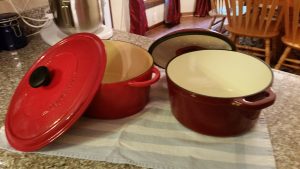
A Dutch oven is a heavy, round or oval pot that’s wider than it is tall and has a tight-fitting lid. They’re designed to be useful on the stove top, in the oven or even over the campfire. In fact, they’re the pot you probably think of when you imagine what settlers cooked in. Frankly, you could do all your cooking in one. They’re almost always made of cast iron, so they’re excellent for a myriad of tasks: deep-frying, searing, simmering and braising. The most useful size is about 5 quarts, although I have a 3 quart one that’s pretty awesome for small households. Prices for that size can range from $35 for a perfectly serviceable plain cast iron one to $300+ for a fancy French enamel-coated one. If I were buying one today, I’d aim for something in the $50 range.
A wok
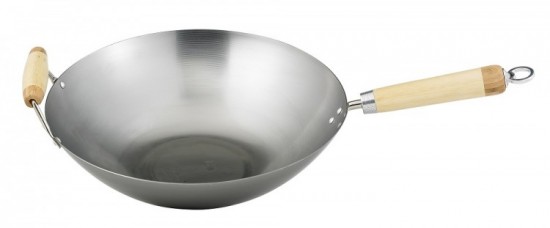 Your decision to get a wok will depend entirely on how much you want to make Asian food at home. If you’re at all serious about it, you’ll want one. It’s a cone-shaped pan (still called a pan even though they have two handles) designed to be used over very high heat and concentrate that heat at the bottom while the sides stay relatively cool. Don’t buy a wok unless you can see hammer marks or subtle concentric rings going up the sides. Those are used for holding food pulled up from the bottom and sort of storing it on the sides while something else cooks in the high heat in the bottom. The good ones are at least 14” in diameter, made of carbon steel and have a ring to hold the pan steady. If you can, buy your wok in an Asian market. You can get a decent one for less than $30.
Your decision to get a wok will depend entirely on how much you want to make Asian food at home. If you’re at all serious about it, you’ll want one. It’s a cone-shaped pan (still called a pan even though they have two handles) designed to be used over very high heat and concentrate that heat at the bottom while the sides stay relatively cool. Don’t buy a wok unless you can see hammer marks or subtle concentric rings going up the sides. Those are used for holding food pulled up from the bottom and sort of storing it on the sides while something else cooks in the high heat in the bottom. The good ones are at least 14” in diameter, made of carbon steel and have a ring to hold the pan steady. If you can, buy your wok in an Asian market. You can get a decent one for less than $30.
A griddle
A griddle is essentially a skillet with no sides. They’re excellent for cooking flat things that won’t produce much splatter as you cook them, like pancakes, sausage patties or grilled cheese. Strictly speaking, you can cook all those things in a skillet but I find the skillet’s sides get in the way when you’re trying to turn them over to cook the other side. Most griddles are square and I’d get one that’s nonstick. It should be at least large enough to fit 4 pieces of French toast at a time. You should be able to get a perfectly serviceable one for $20.
A grill pan
I know many of you live in apartments or don’t have a place to put a grill. This doesn’t mean you can’t have grilled food! You just have to have a grill pan. Most are square, made of cast iron and have raised bumps across the bottom of the pan to simulate a grill. And I have to admit they do a pretty admirable job of giving you the look and taste of grilled food, sans the actual grill. These run about $20.
(A word of warning: The pans I use every day are wonderful; nonstick, hard anodized aluminum that conducts heat well and cooks evenly. Anodizing is the process where the aluminum pans are treated with electrically-charged sulfuric acid to make them 30% harder than stainless steel and non-reactive with acidic foods the way other kinds of aluminum can be. They have a beautiful matte-black finish and are incredibly durable. That same process has one mildly unpleasant side effect; you can’t wash the pans in the dishwasher. Even thinking about putting them in the dishwasher discolors the finish and starts wearing down that amazingly smooth cooking surface. If you don’t mind hand-washing your pans, hard anodized ones are an excellent choice. If you can’t stand the idea of not being able to wash your pans in the dishwasher, steer clear of hard anodized aluminum ones. There are lots of other choices and I’m sure you’ll find pans you’ll love.)
So there’s the list. As I said earlier, there are a bazillion other kinds of pans; from wee little butter warmers to big oblong salmon steamers to ginormous multi-gallon seafood-boiling pots. As you become more comfortable in the kitchen, you may want to add a few to your pan inventory. But these should get you going as you start on your own personal culinary adventure. Next time: bakeware!
